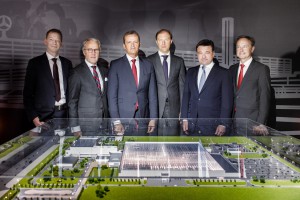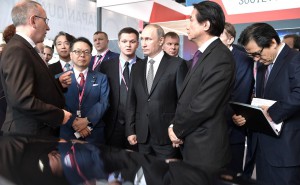
Daimler and Russian officials show off the model for the new Mercedes-Benz plant just outside Moscow.
A recovery in Russia and the Russian-leaning economies of the Commonwealth of Independent States is attracting a growing share of automotive-related investment across the Emerging Europe region, which includes Eastern Europe and Central Asia.
“Companies are being attracted by the prospects of recovery in these markets while in other parts of Emerging Europe investments seem more focused on consolidating SUV production and meeting the demand for more complex new technologies,” according to a new report from BMI Research, a subsidiary of Fitch Group of companies.
BMI’s latest investment round-up of countries in the Emerging Europe region highlighted 21 new investment projects that were either announced or inaugurated in the second quarter of 2017. Reversing trends that saw investment flows into Russia slow dramatically after the 2008–09 financial crisis and hit again by the start of conflict in the eastern Ukraine in 2014.
Three key themes surfaced across the region, including the performance of Russia and the Commonwealth of Independent States (CIS), Volkswagen’s multi-brand SUV strategy maturing in Central and Eastern Europe, or CEE, and the rising technological capabilities of suppliers and manufacturers in CEE.
(Nissan running with the bulls in Russia. For the story, Click Here.)
“The most notable aspect of our investment round-up this quarter is the apparent outperformance of markets in the far east of Europe and in Central Asia, namely Russia and the CIS economies,” the report noted.
“Of the 21 projects announced, 12 were located in Russia, Kazakhstan or Uzbekistan with at least three of these projects being valued $100 million in projects ranging from passenger cars to commercial vehicles and even electric vehicles.”

Russian President Vladimir Putin, center, listens as Nissan executives discuss plans to add 450 workers to its St. Petersburg plant.
“Here, we believe automakers across the spectrum are attempting to bring new or refreshed models to market to be ready to capitalize on a recovery, after low oil prices over 2014–16 sent these markets into a free fall,” the report added.
PSA Group, which will soon take control of General Motors European assets, has been particularly prolific here, having announced its $150 million joint venture investment into light commercial vehicle production in Uzbekistan.
This announcement not only places the company in good stead for dominating future growth in the untapped Uzbek LCV market but it also rounds off PSA’s broader regional strategy in the area. Indeed, the company’s Uzbekistan investment must also be analyzed in the context of its earlier investments in plants in Belarus (October 2014) and Kazakhstan (December 2014) as well as its current plant in Russia.
(Click Here for details about Daimler’s new plant in Russia.)
With all four plants the company now has a diverse and strong network across the region which will benefit the company as sales start to recover.
Meanwhile, Volkswagen’s strategy for bringing a wider range of SUVs and crossovers to the line-ups of each of its brands is further maturing this quarter.
Audi’s announcements for the Q8 and Q4 to begin production in Slovakia and Hungary and Skoda’s commitment to producing the new Karoq SUV at its Kvasiny plant must both be seen in the context of earlier investments like Skoda’s investment in building the Seat Ateca, Audi’s introduction of the Q3 SUV to its Hungary facility, and the decision to build Bentley Bentayga body parts in Bratislava.
The latest investments, therefore, show a maturation of the Volkswagen conglomerate’s strategy of producing a wide variety of SUVs for all its brands while using common modular platforms and concentrating SUV production for multiple brands in each plant to find cost savings.
In addition, BMI said new products are now being produced by CEE suppliers in line with the rise of advanced technologies.
(To see more about how Detroit’s Big Three are dealing with adapting to a global market, Click Here.)
For example, in line with the rise of Advanced Driver Assist Systems (ADAS), sensor demand is rising and Hella’s investment into a new sensor and electronics plant in Lithuania reflects how CEE producers are helping to supply this demand. Similarly, with the rise in electric vehicles, demand for battery components is rising, prompting companies like Shinheung SEC to set up production activities in the CEE region.
